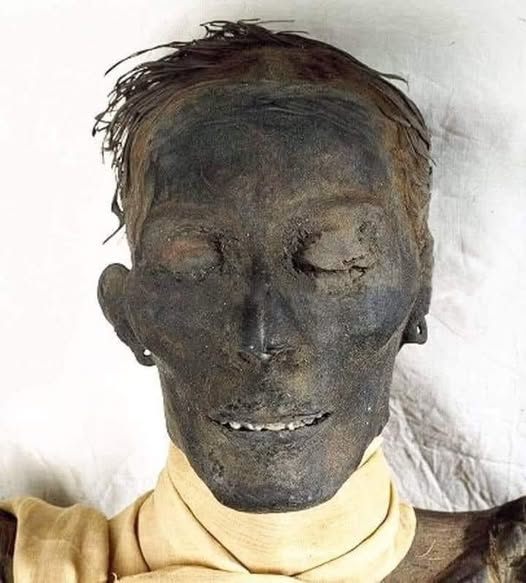In this post, you will explore images from the tomb of Tutankhamun in the Valley of the Kings, an exact replica of his burial site at Howard Carter’s house, the tomb of Pharaoh Ay—who is believed to have taken over the tomb initially intended for Tutankhamun—and artifacts from the Cairo Museum, which will soon be relocated to the new and spectacular Grand Egyptian Museum in Giza.

Through objects, tomb paintings, hieroglyphs, and treasure found in four different locations, we will uncover the fascinating story of Tutankhamun.
Who Was Tutankhamun?
Tutankhamun, also known as Tutankhamen, ruled Egypt from approximately 1336-1327 BCE, though some sources suggest his reign lasted from 1334-1325 BCE. Before Howard Carter discovered his tomb in 1922, little was known about him. He was absent from the royal king lists at Abydos and Karnak, which skip from Amenhotep III to Horemheb, omitting Akhenaten, Smenkhkare (who may have been Akhenaten’s brother or son), and Tutankhamun himself. There is still debate among Egyptologists regarding Smenkhkare’s gender and whether Tutankhamun was their younger sibling.
During his reign, Tutankhamun restored Egypt’s traditional religious practices, reversing the drastic changes implemented by his father, Akhenaten. Akhenaten had abandoned Egypt’s pantheon of gods in favor of the Aten—a sun god represented as a solar disk—leading to widespread unrest. He even moved the royal court to a newly built capital, Akhetaten (modern-day Amarna). However, upon ascending the throne, Tutankhamun reinstated the old gods, abandoned Amarna, and restored stability to Egypt.
Tutankhamun’s Famous Burial Mask
One of the most iconic discoveries in Tutankhamun’s tomb was his golden funerary mask, which was placed over his mummified head. Currently housed in the Cairo Museum, it will soon be the centerpiece of the Grand Egyptian Museum near the pyramids of Giza.
Inside Tutankhamun’s Tomb
Upon entering Tutankhamun’s tomb, visitors immediately encounter his mummy. Moving further inside, they reach his burial chamber, where a striking scene on the north wall depicts his arrival in the afterlife.
The artwork is divided into three parts:
- On the right, Tutankhamun’s vizier and successor, Ay, is seen performing the “Opening of the Mouth” ceremony on Tutankhamun’s mummy. This ritual was believed to allow the deceased to speak in the afterlife.
- In the center, Tutankhamun is greeted by the goddess Nut, protector of the dead as they enter the afterlife.
- On the left, Tutankhamun is embraced by Osiris, the god of the underworld, while his ka (spiritual double) follows him.
On the east wall, a procession of twelve mourners pulls his mummy on a sledge. Among them are high-ranking officials, including Ay, Horemheb, and Maya, his chief treasurer.
The west wall features text from the “Amduat,” a funerary book guiding Tutankhamun’s journey through the twelve hours of the night. The solar barque of Ra and a scarab beetle symbolize the eternal cycle of life.
Colors in Tutankhamun’s Tomb Art
Egyptian tomb paintings used six symbolic colors:
- White represented purity and sacredness.
- Black symbolized death and the underworld but not evil.
- Red conveyed power, fire, and sometimes destruction.
- Yellow was linked to gold, the eternal, and the gods.
- Blue represented the heavens, water, and rebirth.
- Green symbolized vegetation, new life, and resurrection.
The Replica Tomb at Howard Carter’s House
A visit to Carter’s house allows visitors to see a full-scale replica of Tutankhamun’s tomb, including the south wall painting depicting the pharaoh’s entrance into the underworld, guided by Anubis and greeted by the goddess Nekhbet.
The Tomb of Ay: A King’s Betrayal?
Because Tutankhamun died before his tomb was completed, he was buried in a hastily prepared, smaller tomb. His successor, Ay, claimed the larger, more elaborate tomb that may have originally been meant for Tutankhamun.
Ay’s tomb features similar artwork but shows evidence of later desecration. His name and cartouches were chiseled out, and his sarcophagus was smashed—possibly at the orders of Horemheb, who believed he should have been king instead of Ay.
Tutankhamun’s Artifacts in the Cairo Museum
Among the treasures found in his tomb were:
- A solid gold coffin inside multiple layers of sarcophagi.
- A statue of Anubis, placed at the entrance of the treasury room.
- A gilded canopic shrine protecting the pharaoh’s organs.
- A golden throne with depictions of Tutankhamun and his wife, Ankhesenamun.
- Tomb guardians, possibly representing his ba, or spiritual essence.
- A mysterious iron dagger believed to have been made from meteorite metal.
How Did Tutankhamun Die?
Modern scientific analysis suggests that Tutankhamun suffered from malaria and a degenerative bone disease, which may have contributed to his early death.
Why Is Tutankhamun So Famous?
Despite being a relatively minor pharaoh, Tutankhamun became world-famous due to the discovery of his nearly intact tomb. Most tombs in the Valley of the Kings had been looted long before their excavation, but Tutankhamun’s resting place remained hidden for centuries.
In 1922, after years of fruitless searching, Howard Carter finally uncovered the entrance to Tutankhamun’s tomb. A young Egyptian waterboy named Hussein Abdel Rasoul accidentally stumbled upon a carved stone while digging in the sand to place his water jars. This led to the revelation of a staircase leading to the tomb’s sealed doorway.
When Carter first peeked inside, he famously described seeing “wonderful things.” The discovery was one of the most significant archaeological finds in history, offering an unparalleled glimpse into the burial customs and treasures of ancient Egypt.
Conclusion
Tutankhamun’s tomb, artifacts, and history continue to captivate scholars and enthusiasts alike. His reign may have been short, but his legacy endures—immortalized by the treasures buried with him and the story of their rediscovery. Soon, with the opening of the Grand Egyptian Museum in Giza, a new generation will be able to experience the wonders of Tutankhamun’s world firsthand.





